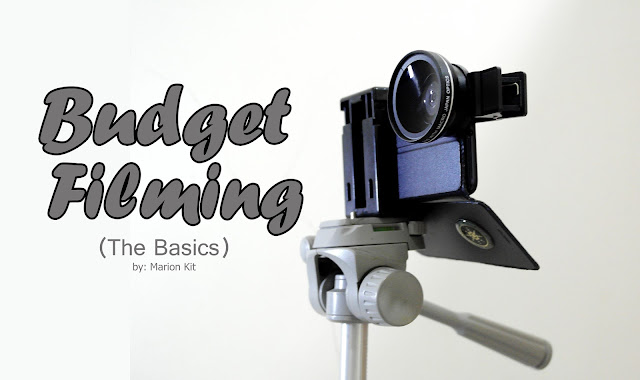"If you are a newbie in filming and you want to learn, stay and read. If you are a Pro in filming, please HELP us learn how to film."
BUDGET FILMING
(The Basics)
Introduction:
Have you ever noticed a Video film that looks a photograph? What I mean here is from the start of the video to the end of the video only one angle is being used. It gets boring. Filming our travels, memories, arts, OOTDs, Vlogs, anything, the video presentation must be eye catching. What I mean is it must always take the attention of our viewers. Remember, human’s listening attention span last for only 10 minutes, visual attention span last only for 3 seconds to a maximum of 10 seconds depending on how interesting a scene is. More than that, our eyes will start looking for another interesting angle.
Filming our memorable activities is one of the most evident materials we can treasure aside from taking photographs. Why not make it more interesting or why not make our travel video clips more hook-able with a great story to tell?
Filming our memorable activities is one of the most evident materials we can treasure aside from taking photographs. Why not make it more interesting or why not make our travel video clips more hook-able with a great story to tell?
Basic filming with slide show.
PART A: THINGS TO REMEMBER
Filming costs a lot of money back in the days, but today, in this generation, it’s not a question anymore because there are plenty of budget-friendly smartphones in the market that are capable of taking good video footage. Take it from me, I am a user of an outdated budget friendly Android phone (2015 model, Android 4.4.2) but I can still make good video teasers from it as well as taking and making great photographs.
Here are basics of filming using only our mobile phones.
I. Things to consider: GEARS & ACCESSORIES
A. Camera: Any smartphone cameras that can video record. 1.3MP is okay, 8MP is Fine, but I recommend using 13MP with 2.0f lens or better. It will give you a better footage than those of lower resolutions. Much better if the video setting has Auto Exposure Lock (AEL) to avoid unwanted exposure adjustments while recording. Most budget smartphones today have AEL.
B. Accessories:
a. Monopod or selfie stick: I use this not just as a “selfie” stick but as a guide/balancer/for more support to avoid shaky footage.
b. Smart Phone Holder: So you can attach your smartphone to your monopod or tripod.
c. Tripod: This is a must if you want to make a film to avoid unstable and shaky footage. Any kind of tripod as long as it can hold your phone steady.
d. Camera Dolly and Stabilizers: Video footage looks cinematic and professional when it is recorded flawlessly. There are affordable camera dolly and stabilizers available today or you can make one your own.
e. Lens: This will help you eliminate the limitation of your built-in lens. There are wide, macro, and zoom lenses available in the market. I am not a fan of zoom lenses in videography. I use wide angle lens. But, the built-in camera is super fine if you do not have a lens.
f. Plug-In Microphone: If you want to make your voice or others (like interviews) clearer you can use a plug-in microphone for smartphones.
g. Battery Charger and Memory Cards: Mobile phones are now equipped with great battery life and huge disk space on our drives. But it’s better to be cautious and prepared. I once covered a debut photo shoot without a battery on my camera. It sucks!
Note: To make your shot clearer and sharper, CLEAN YOUR LENS.
Note: To make your shot clearer and sharper, CLEAN YOUR LENS.
If you do not have any of these accessories, don’t stress because taking and making videos is not limited to these accessories only because your smartphone alone, be it Android or iPhone, can take and make better videos. Wait, is iPhone a budget phone? If it is to you, then am not gonna question it. :D
The woman was using a high-end DSLR with 70-200mm L lens with a monopod, the guy behind me was using a High Definition TV camera with a powerful tripod... then me using only an outdated smartphone for documenting an event. I don't know if am gonna be proud of it or am gonna be ashamed of it.
II. Things to Remember:
A video presentation even if it last only for 10 seconds to 5 minutes is a tool for storytelling. Remember our Literature? A story must have continuity and harmony.
A. Plan your story shots. It has been observed that many video presentations are done with no continuity and harmony. As long as all captured clips are stitched in one film, or "am gonna use this transition style because looks cool", then it’s okay. Many used different kinds of transitions resulting to a horrible video presentation. Cuts and Transitions aren’t done properly. Cut and transitions aren’t just cuts and transitions; they are made by experts as a tool to tell a better story.
B. Do the 3 seconds rule: As I said before, the visual attention span of man usually last from 3 seconds to the maximum of 10 seconds depending on how interesting the subject is. So take your clips only from 3 seconds to the maximum of 10 seconds.
C. Remember your shots: In taking videos, take many clips as you want and always remember your shots so you can have a mental outline on how you will stitch your clips later when you edit your videos.
PART B: The BASICS
A. CAMERA SETTING:
a. Set your camera to video/recording mode then, if there’s Manual Mode and AEL, set it.
b. Use 24fps if your phone has it because your footage will look more natural.
c. Select your background. Make sure that your subject will stand out from your background. Be aware if there are too overexposed or underexposed areas because smartphones will auto change its exposure to the brightest/darkest area.
d. Enable flight Mode: This is to eliminate notification distractions while you are filming unless you do it on purpose.
B. PLAN YOUR SHOTS:
a. How to record: Do Panning, Zooming in and out, hand held or using hand-held stabilizers. (More on this below on Basic Camera Cuts, Transitions, and Movements.)
b. Compose like photography’s composition: Framing, the rule of thirds, panning, zooming in and out, and breaking the rules is the same in filming. But. . .
c. Compose like a pro videographer: In filming, let the camera speaks the unspoken words. Notice some movies that do not have words but it speaks to you using only camera movements?
Here's an example from Carl and Elie from the movie, UP:
Travel and teaser films must follow this principle. Telling your viewers an interesting easy to understand story.
Here's an example from Carl and Elie from the movie, UP:
Travel and teaser films must follow this principle. Telling your viewers an interesting easy to understand story.
C. BASIC CAMERA CUTS, TRANSITIONS, AND MOVEMENTS
There are so many skillful people who are superb in taking and editing videos but I’ve noticed that many videos uploaded on the social media were GREATLY edited but not hitting a story.
Here are some videos from YouTube that can explain well about the basics of Cuts, Transitions, and camera movements:
a. CUTS AND TRANSITIONS
b. CAMERA MOVEMENTS
III. SOUNDTRACK and APP
On Sound Track:
Have you noticed while you are singing in a karaoke bar, have you notice the videoke/karaoke machine's background while you are singing “Close to you” by the Carpenters? It’s wrestling mania or an NBA games!!! WOW so intense!
Soundtrack must be inviting. Generally, it must not be too hard or too soft, too loud or too deafening but it depends on the type of your footage. When the music beats start getting fast, it is also agreeable that the movie phase should be fast.
Soundtrack and video phase must rhyme with each other.
On APP Video Editor:
On APP Video Editor:
iPhone has great built-in app for video editing :D Sad to say Android doesn't have superb video editing built-in App or it's app just doesn't fit my style.
There are lots of video editors from Google Play you can choose.
IV. MY THOUGHTS
I am one of those guys who doesn’t know what I am doing in making videos. LOL! I’ve been editing video teasers of Debut, Weddings, and Event Coverage before but I did not apply my learnings due to deadlines or time constraint because of work. It made me an idiot. My output looks fair enough, some love it but, upon reviewing my li’l knowledge while making this post, I totally suck in making videos.
Next time am gonna make it better by remembering and applying what I’ve learned before. I know this will take time but I have to for the sake of Art. :D
~ THANK YOU ~
















0 Comments